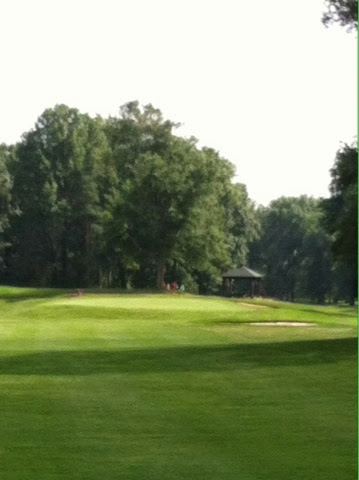Huntley has had success remodeling old golf courses. Eagle Creek and Sanctuary are both very well done. Ellsworth is a big improvement over what was there but it's not in the category of those two. There's four holes I'm not keen on, 3 8 13 15. Three is a long par four that has a double dogleg first right then left. If you drive it in left part of fairway then you're blocked out by the trees. I think it's silly that blowing it out to the right is the best angle to green. The approach is good as a lake behind green is a great view and encourages a low running shot. Eight is a long par four that doglegs left but cambers right. A draw is the only shot that works. Trees line entire left side and a fade is death. Next, Thirteen has a great green setting set into the hill with a rock bottomed creek on left. Unfortunately the drive is too damn narrow as you hit out of chute. I like to call it a "Big Springs" tee. Finally fifteen is a strong dogleg left that climbs up a hill but there is no reason for the addition to the green. It's just plain goofy. The left "green" is perfectly fine for the approach.
The par five fifth is a fine hole but what is up with the tree in the middle of the fairway? It's not even a big beautiful tree. Stay left all the way down the hole. Even the rough is better than being behind the tree. Also, the green on eleven has a large hump in the rear making for an awkward back pin placement on this par five. Many shots hit the slope and shoot over the green into the brush. Coming up short is no good either since the putt is likely to roll off the green. Flatten it out! Its good hole otherwise.
The holes that do shine are the par threes. Varied and full of strong character they are a pleasure to play. The seventh is arguably the best hole on the course. The beauty of the hole belies it's challenge. The green has a hump in the middle which will spin offline shots away for the flag. A well played shot offers a chance at two. Nine plays along the road in view of the barn. Used to be a short par four but Huntley changed it. Good vision on his part. It's also fun watching your playing partners hit high slice off the barn too.
The last two holes are a great way to finish. Seventeen is a great do or die par five. A big drive can be rewarded with a gambling long iron over the lake to the green. Those who can't reach still can play aggressive by hitting close to the lake edge and opening up the angle to the pin. It's a wonderful par five and possibly Huntley s best. Then eighteen is a good par four that doglegs right with a trap in the elbow and wetlands on the left. Put it in play and a well struck shot can lead to birdie. But a poor drive is punished quickly.
Ellsworth has a strong local backing. Most of that is due to the aforementioned amenities. The course is kept in good shape and is fun to play. When I first saw Ellsworth, I was thinking it would be another Brookledge, but it doesn't compare to its neighbor just down the interstate. I would give it a 4 (above average) rating.























